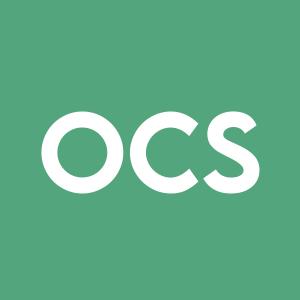Oculis Accelerates Privosegtor into Registrational Trials in Acute Optic Neuritis, Pioneering the Path for a Potential First-in-class Neuroprotective Therapy
Rhea-AI Summary
Oculis (Nasdaq: OCS) announced a positive meeting with the FDA and is launching the PIONEER program to advance Privosegtor into registrational trials for acute optic neuritis (AON) and non-arteritic anterior ischemic optic neuropathy (NAION).
The company plans three pivotal studies: PIONEER-1 (Q4 2025), PIONEER-2 (1H 2026), and PIONEER-3 (mid-2026). Primary endpoint: low-contrast visual acuity (LCVA) at 3 months, with dosing/enrollment mirroring the positive Phase 2 ACUITY trial. Oculis reported preliminary cash, cash equivalents and short-term investments of ~$182 million, with runway expected into 2H 2027. Full Q3 2025 results are planned for November 10, 2025.
Positive
- FDA positive meeting enabling registrational program (Oct 6, 2025)
- Three pivotal trials planned: PIONEER-1 Q4 2025; PIONEER-2 1H 2026; PIONEER-3 mid-2026
- Primary endpoint set: LCVA at 3 months
- Phase 2 ACUITY showed improvement and informed pivotal design
- Preliminary cash balance of ~$182 million
Negative
- Cash runway expected only into 2H 2027
Insights
FDA clearance to proceed to pivotal trials and clear timelines accelerate Privosegtor toward registration.
The article states the FDA meeting was positive and Oculis will start the PIONEER program with three pivotal trials: PIONEER-1 (Q4 2025), PIONEER-2 (1H 2026), and PIONEER-3 (mid-2026).
What it means: a regulatory pathway is defined for acute optic neuritis (AON) and NAION, allowing concurrent pivotal studies that share core design elements and endpoints (primary endpoint: low-contrast visual acuity at 3 months), which may streamline data collection and regulatory submissions.
Why it matters: registrational trials with prespecified endpoints and EMA/US IND alignment reduce key development risk and convert prior Phase 2 topline findings into potentially licensable evidence; monitor initiation dates and the disclosed primary endpoint as concrete milestones to judge progress.
Advancing three concurrent registrational trials while reporting
The press release reports
What it means: funding appears sufficient to launch the PIONEER program and run near-term pivotal activities; concurrent trials may create operational synergies and possible cost efficiencies as claimed, but they also increase near-term burn and execution complexity.
Why it matters: the combination of a cleared regulatory path and an identified cash runway materially affects program feasibility and timelines; key monitorables are trial start dates, enrollment pace, and the upcoming Diamond Phase 3 DME top-line results mentioned for near-term catalyst context.
ZUG, Switzerland, Oct. 06, 2025 (GLOBE NEWSWIRE) -- Successful meeting with FDA enables advancement into pivotal development with Privosegtor in Acute Optic Neuritis (AON) and Non-arteritic Anterior Ischemic Optic Neuropathy (NAION)
Oculis will launch the PIONEER Program, which includes multiple global trials intended to support registrations in AON and NAION
Company to host conference call and webcast at 8:30 AM ET today
Oculis Holding AG (Nasdaq: OCS / XICE: OCS) (“Oculis”), a global biopharmaceutical company focused on innovations addressing neuro-ophthalmic diseases with significant unmet medical needs, today announces the advancement of Privosegtor into a registrational program for neuro-ophthalmology indications following a positive meeting with the U.S. Food and Drug Administration (FDA).
Privosegtor is a new peptoid small molecule candidate with the potential to become the first neuroprotective therapy for acute optic neuritis (AON) and non-arteritic anterior ischemic optic neuropathy (NAION), with potential in other neuro-ophthalmic and neurological diseases. Following FDA feedback, the company is starting the PIONEER program this year, which will include three pivotal trials to support registration plans for Privosegtor in AON and NAION.
- PIONEER-1 trial in AON (Q4 2025)
- PIONEER-2 trial in AON (1H 2026)
- PIONEER-3 trial in NAION (mid-2026)
The first two trials, PIONEER-1 and PIONEER-2, will evaluate Privosegtor following the acute onset of optic neuritis in a broad population consisting of patients with multiple sclerosis (MS) and those without MS. The primary endpoint will be measured as low-contrast visual acuity (LCVA) at 3 months. Dosing and patient enrollment criteria will mirror those of the positive Phase 2 ACUITY trial, which demonstrated improvement in visual function and anatomical preservation of the retina in patients with AON. PIONEER-1 is expected to initiate in Q4 2025, with PIONEER-2 planned to follow in the first half of 2026.
The FDA provided guidance that Privosegtor can be evaluated in other neuro-ophthalmology indications, such as NAION, under the current IND. The third trial in the PIONEER program, PIONEER-3, will evaluate Privosegtor after the acute onset of NAION. This study shares the core design and operational elements with PIONEER-1 and PIONEER-2, and is expected to begin in mid-2026. Running these three studies concurrently is expected to generate operational synergies, cost efficiencies, and speed up development timelines.
AON and NAION are two rare neuro-ophthalmic diseases with high unmet medical needs for a therapy that can provide neuroprotection and preserve vision. AON is often the first clinical symptom of multiple sclerosis. While corticosteroids are used to treat inflammation in AON, there are no approved neuroprotective therapies that can restore vision for patients suffering from acute optic neuritis. Likewise, no medical or surgical treatment has been shown to improve the prognosis in cases of acute NAION.
Riad Sherif, M.D., Chief Executive Officer of Oculis, commented: “The positive FDA meeting marks a significant milestone for our rapidly advancing neuroprotection candidate. The PIONEER program positions Oculis as a leader in ophthalmic neuroprotection drug development. The novel Privosegtor candidate provides the Company with multiple opportunities to target devastating diseases with significant unmet medical needs in late-stage trials. With this milestone and the upcoming top-line results from Diamond Phase 3 DME program, Oculis is now in a strong position with multiple pivotal studies, targeting multi-billion-dollar markets.”
Mark Kupersmith, M.D., Chief Medical Advisor, Neuro-Ophthalmology, added: “I am very pleased that the Company is accelerating its development plan with Privosegtor in optic neuropathies, including acute optic neuritis and NAION, given the critical unmet medical needs remaining. Neuroprotection represents a promising therapeutic approach across multiple neuro-ophthalmic conditions and although the cause of optic nerve injury can be different, patients experience permanent loss of optic nerve axons and retinal ganglion cells causing permanent visual deficits. Privosegtor’s potential neuroprotective benefits and the studies we are conducting, as part of the PIONEER Program, could have a profound impact on patients’ lives.”
Leonard A. Levin, M.D., Ph.D., Professor, Departments of Ophthalmology & Visual Sciences and Neurology & Neurosurgery, McGill University, said: “The positive ACUITY topline results represent a remarkable step forward in neuroprotection trials. I have been involved in this area for more than three decades, and this candidate is the first to show significant improvement in clinical, biological, and imaging measures of the disease in a single trial. I look forward to contributing to the testing of Privosegtor for a broad spectrum of neuro-ophthalmic and neurological diseases.”
As of September 30, 2025, Oculis’ preliminary unaudited cash, cash equivalents and short-term investments was approximately
Analyst and investor call
The Oculis management team will host an analyst and investor call today at 8:30 AM U.S. Eastern Time.
Interested parties may participate in the call via the following link:
https://lifescievents.com/event/al307vskt98/
A replay of the webcast and accompanying slides will be available for 90 days following the event through the “Events and Presentations” page of the “Investors and Media” section of the company’s website.
- END -
About Privosegtor
Privosegtor is a novel peptoid small molecule candidate with the potential to become the first neuroprotective therapy for acute optic neuritis (AON) and other neuro-ophthalmic diseases. The positive results in the ACUITY Phase 2 trial showed Privosegtor’s potential neuroprotective effects through anatomical preservation of the retina and visual function improvements after an acute episode of optic neuritis. Consistent results were observed in animal models of neuroinflammation and neurodegeneration, where Privosegtor showed preservation of retinal ganglion cell damage and was associated with improvements in mobility (clinical function disability). Privosegtor has received Orphan Drug designation from both the FDA and the EMA for AON and is now entering registrational trials for this indication as well as a registrational trial in nonarteritic anterior ischemic optic neuropathy (NAION) as part of Oculis’ PIONEER (Privosegtor Investigation in Optic Neuropathies Efficacy Evaluation Research) program. In addition to its potential effect on neuroprotection of the optic nerve, Privosegtor could also have wide applicability in treating other neuro-ophthalmic and neurology indications.
Privosegtor is an investigational drug and has not received regulatory approval for commercial use in any country.
About Acute Optic Neuritis
Acute Optic Neuritis (AON) is a rare condition characterized by an acute inflammation of the optic nerve that can lead to permanent visual impairment. It affects up to 8 in 100,000 people worldwide with a U.S. incidence estimated to be >30,000 and often represents the first sign of multiple sclerosis1. It mainly occurs in adults between the age of 20 and 40 years and is more frequent in women (2:1)2. The acute inflammatory process of optic neuritis leads to the loss of myelin covering the optic nerve and the axons. At the onset, patients often suffer from ocular pain that increases with eye movement and vision loss. Once the inflammation recedes, remyelination often occurs but it is incomplete. Without the myelin sheath protecting the axon, neurons located in demyelinated segments become fragile and prone to death. Unfortunately, damaged axons cannot regrow, leading to permanent visual impairment. Though most patients do not have permanent severe vision loss, visual impairment for images and things of low contrast is a common impairment. This can interfere with reading, pattern recognition and seeing on gray or cloudy days. To date there is no specific neuroprotective therapy approved for AON and unmet needs remain for therapies that can prevent vision loss after an acute episode of optic neuritis.
About Non-arteritic Anterior Ischemic Optic Neuropathy
Non-arteritic anterior ischemic optic neuropathy (NAION) is an acute optic nerve disorder and the most common cause of acute optic nerve injury in individuals over 50 years old3. It affects up to 10.2 per 100,000 people worldwide4 with a U.S. incidence estimated to be >30,0003,5,6. NAION and Acute Optic Neuritis (AON) injure the optic nerve leading to progressive axonal loss and visual decline, after the acute event. In NAION, the optic nerve head region swells and there is painless sudden vision loss. The swelling eventually resolves, but the optic nerve axons and neuronal cell bodies (in the retina) are permanently lost, leading to significant visual impairment or even irreversible blindness7. There are no approved therapies for NAION and there remains an unmet medical need for therapies that preserve vision and provide neuroprotection for patients suffering from NAION.
About Oculis
Oculis is a global biopharmaceutical company (Nasdaq: OCS; XICE: OCS) focused on innovations addressing neuro-ophthalmic conditions with significant unmet medical needs. Oculis’ highly differentiated late-stage clinical pipeline includes three core product candidates: Privosegtor, a neuroprotective candidate in the PIONEER program which consists of studies intended to support registration plans for treatment in optic neuropathies like acute optic neuritis (AON) and non-arteritic anterior ischemic optic neuropathy (NAION), with potentially broad clinical applications in various other neuro-ophthalmic and neurological diseases; OCS-01, an eye drop in pivotal registration studies, aiming to become the first non-invasive topical treatment for diabetic macular edema; and Licaminlimab, a novel, topical anti-TNFα in Phase 2, is being developed with a genotype-based approach to drive personalized medicine in dry eye disease. Headquartered in Switzerland with operations in the U.S. and Iceland, Oculis is led by an experienced management team with a successful track record and supported by leading international healthcare investors.
For more information, please visit: www.oculis.com
-ENDS-
Oculis Contacts
Ms. Sylvia Cheung, CFO
sylvia.cheung@oculis.com
Investor Relations
LifeSci Advisors
Corey Davis, Ph.D.
cdavis@lifesciadvisors.com
Media Relations
ICR Healthcare
Amber Fennell / David Daley / Sean Leous
oculis@icrhealthcare.com
Cautionary Statement Regarding Forward Looking Statements
This press release contains forward-looking statements and information. For example, statements regarding the development plans for Privosegtor; the design and timing of clinical trials of Privosegtor; potential effects of Privosegtor, including patient impact and market opportunity; the potential of Privosegtor to be a neuroprotective therapy or treatment for AON, NAION and other neuro-ophthalmic diseases; the potential for the Privosegtor clinical development plan to result in operational synergies, cost efficiencies and accelerated development timelines; the Company’s estimated cash, cash equivalents and short-term investments and cash runway; and Oculis’ research and development programs, regulatory and business strategy, future development plans, and management, are forward-looking. All forward-looking statements are based on estimates and assumptions that, while considered reasonable by Oculis and its management, are inherently uncertain and are inherently subject to risks, variability, and contingencies, many of which are beyond Oculis’ control. These forward-looking statements are provided for illustrative purposes only and are not intended to serve as, and must not be relied on by an investor as, a guarantee, assurance, prediction or definitive statement of a fact or probability. Actual events and circumstances are difficult or impossible to predict and will differ from assumptions. All forward-looking statements are subject to risks, uncertainties and other factors that may cause actual results to differ materially from those that we expected and/or those expressed or implied by such forward-looking statements. Forward-looking statements are subject to numerous conditions, many of which are beyond the control of Oculis, including those set forth in the Risk Factors section of Oculis’ annual report on Form 20-F and any other documents filed with the U.S. Securities and Exchange Commission (SEC). Copies of these documents are available on the SEC’s website, www.sec.gov. Oculis undertakes no obligation to update these statements for revisions or changes after the date of this release, except as required by law.
The financial information in this release reflects the Company’s preliminary estimate, based on currently available information. Financial closing procedures for the quarter are not yet completed and final results may therefore vary from this estimate. This preliminary estimate has not been audited by the Company’s independent registered public accounting firm.
References :
- Martínez-Lapiscina EH, et al. (2014): Is the incidence of optic neuritis rising? Evidence from an epidemiological study in Barcelona (Spain) 2008-2012. J Neurol. 2014 Apr; 261(4): 759-767.
- Pérez-Cambrodí RJ, Gómez-Hurtado Cubillana A, Merino-Suárez ML, Piñero-Llorens DP, Laria-Ochaita C. Optic neuritis in pediatric population: a review in current tendencies of diagnosis and management. J Optom. 2014 Jul-Sep;7(3):125-30.
- https://www.aao.org/eyenet/article/naion-diagnosis-and-management
- Kuppersmith, MJ et al. (2024): Ophthalmic and Systemic Factors of Acute Nonarteritic Anterior Ischemic Optic Neuropathy in the Quark207 Treatment Trial. 2024 July;131(7):790-802.
- Hattenhauer M G et al. (1997): Incidence of nonarteritic anterior ischemic optic neuropathy. American Journal of Ophthalmology. 1997 Jan;123(1):103-7.
- Lee M S et al. (2011): Incidence of nonarteritic anterior ischemic optic neuropathy: increased risk among diabetic patients. Ophthalmology 2011 Mar 24;118(5):959-963
- North American Neuro-Ophthalmology Society website: https://www.nanosweb.org







